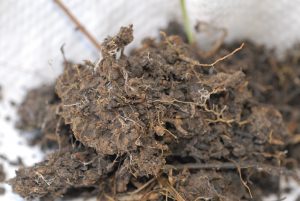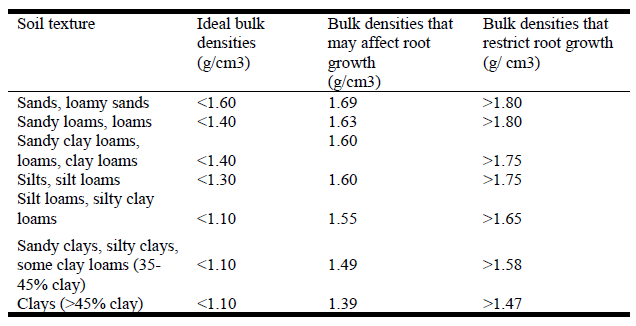I was taught in horticulture school that the ideal soil is composed of 50% solids and 50% voids or spaces which are themselves composed of a variable amount of water from small amounts to as much as 25% water when the soil is at field capacity or the amount of water left in soil after gravity has pulled all the free water down in the profile. So the “ideal” soil always has 25% pore spaces or more depending on how much water is present. These conditions are vital for root growth since roots go through the chemical process of respiration which involves absorbing oxygen and giving off carbon dioxide. For gas exchange to happen in this ideal soil, spaces or voids are important, and necessary. A well-structured soil has micro aggregates (pea sized or smaller clumps of soil) in high concentrations which creates many of these spaces and is said to have high porosity.

Porosity – the amount and types of voids – is determined by two major factors: 1) The size and distribution of the soil particles; and 2), how those particles are arranged. Sand, silt, and clay particles can be arranged and formed into pathways that help move air and water. These paths are formed by past root channels and the movement of organisms like worms and insects. These channels are glued together by exudates from roots, bacteria and fungi. This organic, both living and dead, soil fraction also add and stabilizes porosity. All together, soil particles, plant residues and microorganisms create a fragile structure that adds more porosity than just the pores and voids created by spaces between the soil mineral particles.

Structure and porosity can be physically destroyed or crushed. The soil can be squished by heavy equipment or constant foot traffic of animals, such as humans or horses, or others that constantly tread over the same soil. Compacted soil can be near the surface (the worst for trees since their roots are mostly near the surface), or lower down in the profile. A “plow pan” is actually a compacted zone at the depth of plow or ripping agricultural implements where soil structure is constantly destroyed at the same depth over and over. As soon as roots and worms create a new pathway and reinforce it with micro-aggregates and glues, it is destroyed again, creating a zone of loosened soil where the implement has traveled, but a zone immediately below what which has been compacted by the pressure of the implement.
Most horticulturists and many gardeners know that compacted soils are bad for plants growing in them. Shade trees frequently have restricted growth in these kinds of soils. This can happen at a young age when trees are just planted or on large specimen trees, such as in parks that have the soil compacted around them by visitors. Footpaths, picnic tables, playground equipment or any publicly attractive park feature will often have compacted soils in the area.
Deprivation of litterfall and mulch layers, either through wearing out (grinding of organic matter by foot traffic) of the mulch or by mulch/litter removal through raking will promote compaction by removing the cushioning effect of that mulch layer. Sadly, the tree itself can be the feature that attracts people to it, resulting in compacted soils all around its base that limits its health.

What is not so well known is why growth is slowed in compacted soils. The effects of compaction are multi-fold. Compacted soils are less porous because the compaction literally reduces the air pockets in the soil, making it more dense with lower oxygen diffusion rates. Soil with destroyed structure becomes less permeable to water infiltration and holds less water. Under these conditions tree roots may not be adequately hydrated, and cannot physically penetrate the highly compacted soil. Thus, they are not able to develop and expand and explore enough to supply the needs of the tree. Reduced soil oxygen, along with other site, soil, and tree variables such as water and nutrient uptake, are all reasons for restricted tree growth.
There is compelling evidence that different species of trees can exert greater pressure at their root tips to break through compacted soils. Different tree species also have different root architectures – finer, deeper, shallower, etc. Thus, there is a genetic factor in a tree’s ability to deal with this soil problem.
Soils are more or less compactable depending on their texture, structure and moisture status. Generally a dry soil is harder to compact that a moist one. Dry soils resist compaction (but still can be compacted) because the soil aggregates stiffen as they dry. Wet soils are easily compacted but people and machinery also easily sink in very wet soils. Waterlogged soils may or may not have structure, but the water in the pores, prevents further collapse of the soil structure. Soils that are moist (at field capacity) are just right for growing plants, and are also perfect for compacting and thus must be protected from compaction.
Soil compaction is measured by calculating what’s called bulk density (Bd). Bulk density is the weight of soil in a given volume, and is measured in grams/cubic centimeter. In order to measure bulk density a special soil sampling device called an “intact soil core sampler” is used. This device extracts a core of soil while preserving its structure. The volume of the sample is a constant. The soil sample is removed and dried to drive off all the water and then the weight of dry soil is divided by the known sample volume giving the bulk density.
Bulk densities vary depending on the soil texture (%Sand:Silt:Clay) and to a smaller extent on the organic matter content. Sands generally have very large particles, more pore spaces and lower bulk densities than silts, loams and clays which will
A Comparison of Root Limiting Bulk Density for Different Soil Types (NRCS 1998 in Dallas and Lewandowski, 2003)have the highest bulk densities. Thus compaction is determined by measuring both bulk density and soil texture. Generally, pure rock has a bulk density over 2.65 g/cc. Uncompacted sands may have bulk densities of 1.2-1.4, while loams and clays may have Bd from 1.5-1.8 g/cc. A sand may be compact at 1.4 but a clay may have a higher Bd of 1.5 and not be considered compacted. Organic soils can have Bd that are much lower – 0.02-.9 g/cc. Generally, soils (average of all textures) with bulk densities over 1.5 can be suspected to be compacted and will limit tree growth.
Bulk density for a given soil is not a fixed property, it can change depending on the history of what has happened to the soil. For instance, in an annual color bed or vegetable garden bed, the soil may be turned or tilled by the gardener, amended, and replanted. During this process structure is destroyed, but the organic matter, growth of the crop, and time foster a new soil structure, perhaps even more porous than the soil was previously. This can happen in one growing season. In the case of compacted soils around trees, it can take years for a mulch laid over a compacted soil to correct the compaction.
Another way of looking at this is: if you can get the sampler into the soil, its likely not compacted, but if you have to use a hammer to get it into the soil it might be compacted (or dry). Pressure required is going to depend on the soil moisture, as well as the state of compaction. Compaction can also be measured by a device called a penetrometer which quantifies resistance to penetration. We as gardeners can use a screwdriver, if you can push it into soil; it is less compacted than if you can’t. The screwdriver test is also used to test for moisture content–when soils dry out, they resist penetration. The depth of water penetration in an irrigated soil is the depth to where the screwdriver stops when pushed in. So, it is easy to confuse a compacted soil with a dry soil. Also, if a soil is compacted, water will not easily enter, so many compacted soils are also perennially dry soils since irrigation does not easily penetrate them. This can be seen as increased runoff when you try to irrigate or ponding if the compacted zone does not drain away.
How do we fix compacted soils with high bulk densities? I was always taught that chemical fixers like gypsum, soil penetrants, or other chemical means will not affect a structurally damaged and compacted soil. The only way to fix them is to physically un-compact them. So, further destroying structure by ripping, drilling, trenching, air spading, or in some other way breaking up the compacted layers is the thing to do. Basuk (1994) cites cases where soil modified to treat compaction actually re-compacts (bulk density increases) over time (2-3 years after a compaction relieving treatment is applied). Numerous studies indicate that breakdown of arborist chip mulches will lead to reduced bulk density, but little is known about actual bulk density reductions with mulch applications over time. I am confident mulches will reduce bulk density, but given the diversity of soils, textures and compaction levels, I can only imagine this is a variable response. Removing the cause of the compaction, (foot traffic, machine usage etc) is the first step. Mulching following some kind of “soil fluffing” procedure should begin the process of increasing soil porosity and reducing bulk density. It may take years to relieve compaction passively through the action of mulching. If soil can be mechanically broken up, the compaction issue is solved and soil structure will slowly be reformed in time depending on what is grown thereafter.
References:
Bassuk, N. 1994. A review of the effects of soil compaction and amelioration treatments on landscape trees. Journal of Arboriculture 20:9-17.
I’m confused. I thought we weren’t supposed to disturb our soil structure by digging into it. The article recommends “Mulching following some kind of “soil fluffing” procedure.” My lawn is lumpy and uneven and feels hard when I walk on it (although I’ve had it aerated every year for at least 5 years), and I’d like to make it level and feel soft underfoot. What should I do? Thank you.